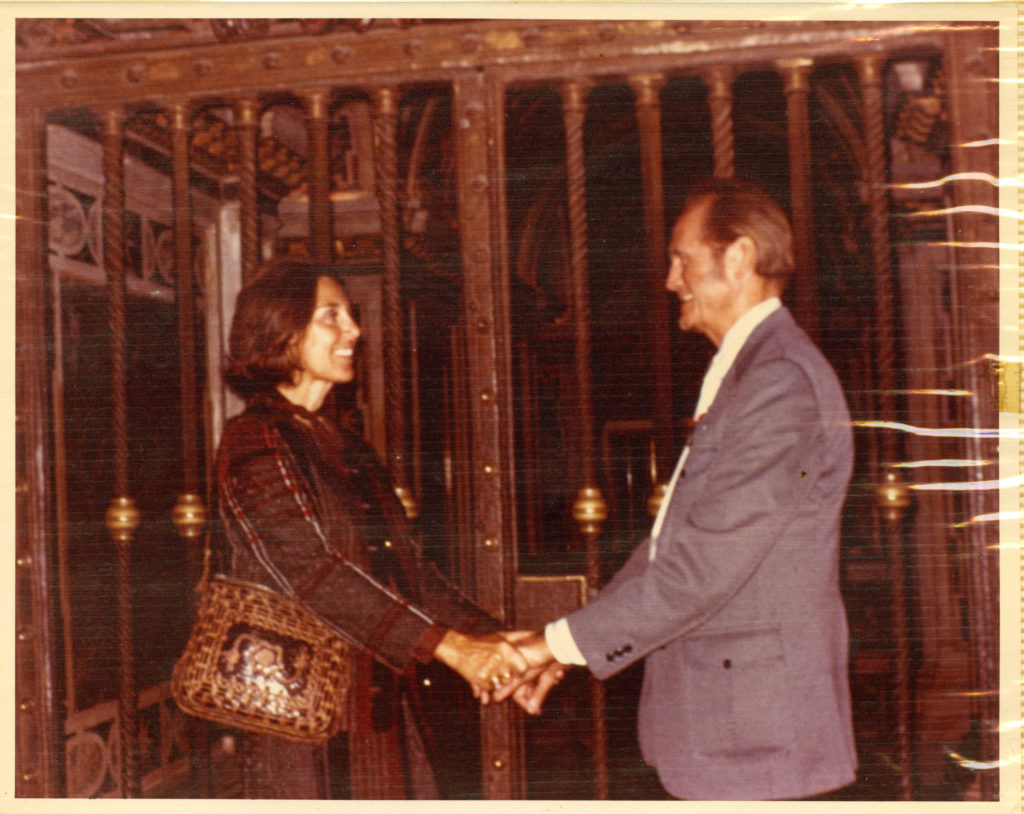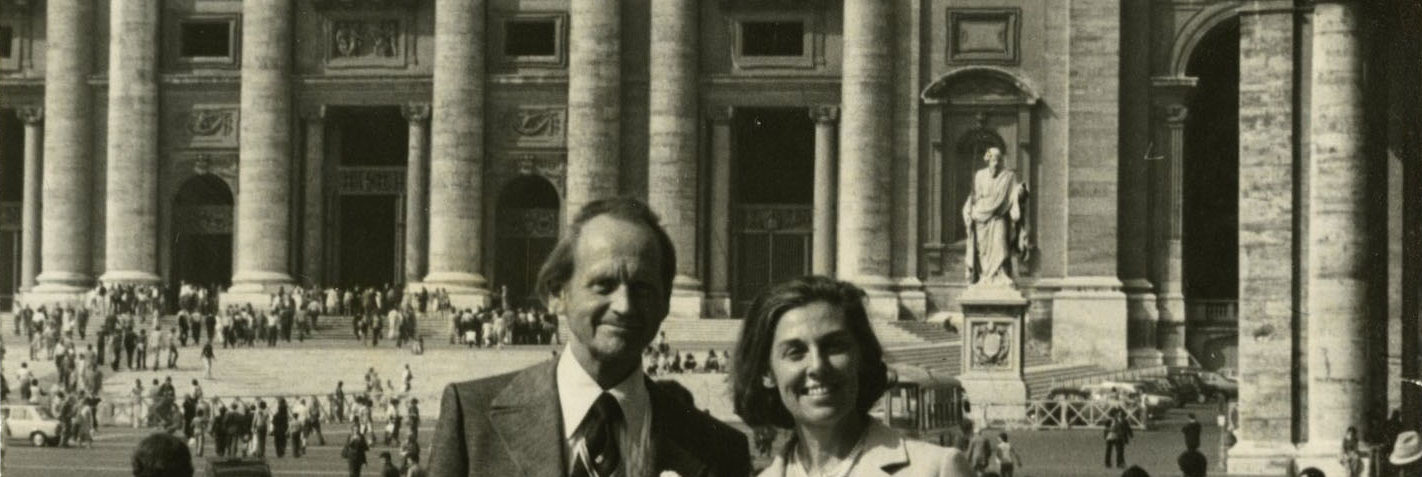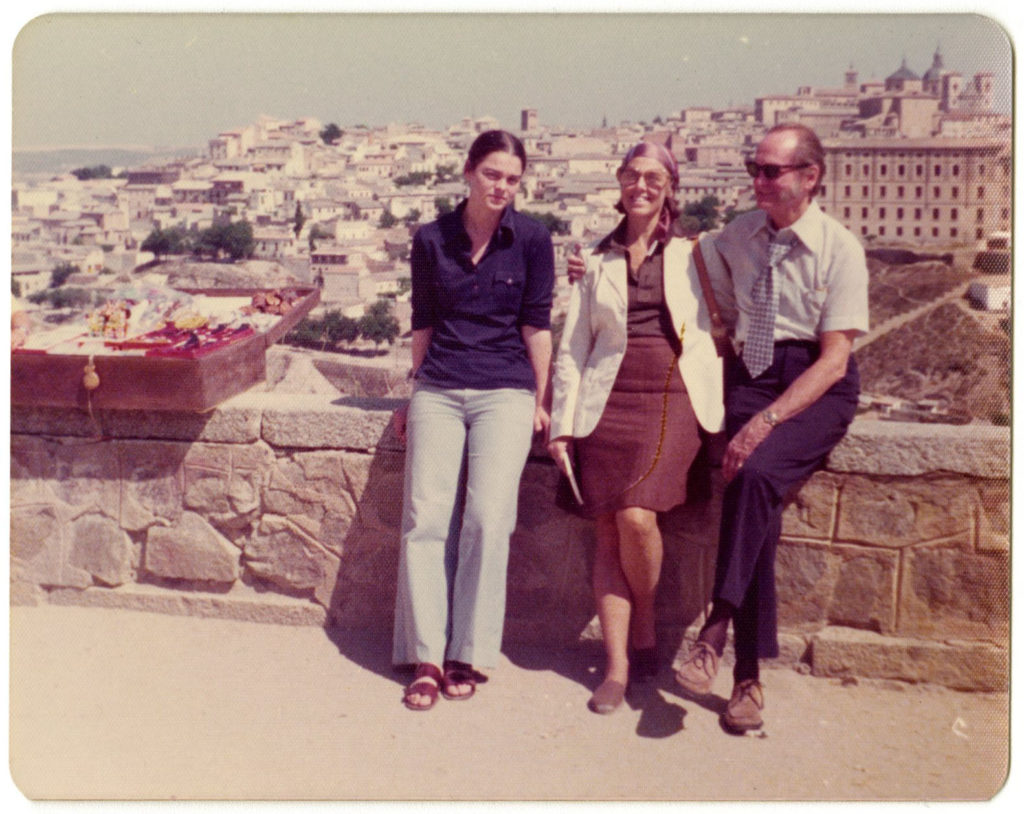A year after getting married in the Vatican, Sybil returned to Rome in order to attend her youngest daughter’s graduation. Just as she had a year before, Sybil arrived in Rome alone. On their first day, Sybil and her daughter Ellen took a day trip to Assisi to attend mass in a small church built on the spot St. Francis lived with his family. This speaks to her influences of faith as well as her influence of kindness. St. Francis of Assisi was known to be a kind saint who lived through charity and peace. Choosing to visit this destination particularly illustrates that within her faith, those who practiced charity and peace left the biggest impact. We can assume from this that these virtues are what she held most important.
Soon Cliff joined Sybil back in Rome and the two attended Ellen’s graduation ceremony. Sybil swoons over the guest speaker, as he is the composer Gian Carlo Menotti, a Christmas favorite of Sybil’s.
In this journal, Sybil expresses a more traditional travel narrative as we see her visiting typical tourist locations. Before leaving Italy, Sybil stops by several museums, including the Vatican, in order to renew the memories of a year before. From Rome the group of three leaves for Madrid, Spain. Mixed in with flamenco dancing, more museums, and shopping is a visit to the birthplace of St. Teresa of Avila. Much like St. Francis, the appreciation of this saint reveals something about Sybil. St. Teresa of Avila was very influential in the Spanish Renaissance, most notably for her literature. St. Teresa wrote mostly of prayer and service, however she also completed an autobiography. Given that this saint was literarily inclined as well as having a deep devotion to the church, we can assume she had a great influence on Sybil as a Catholic female writer herself.

Moving on from Spain, Sybil, Cliff, and Ellen take a ferry across the Strait of Gibraltar to Tangier. On a drive from Tangier to Fez, Sybil illustrates beautifully the culture of Morocco. Using wording such as “brightly colored” and “waving hands of friendly people” we can tell Sybil sees this landscape positively. Later on, she writes that they “passed through other towns with beautiful names”. This tells us that Sybil is appreciative and full of admiration for this foreign country, despite how different it may be.
Sybil includes much historical background for the places she visits within this journal, linking what she sees to what she has read about. On a trip through Roman ruins, Sybil points out that these were the ruins found in the film Patton (1970). Even though she links a piece of Moroccan/Roman history to current U.S. pop culture, Sybil quickly drifts back into historical trivia of the destinations she visits, such as pointing out the important center of commerce the city of Meknes has become.
Upon arriving in Marrakech, the discussion of colonialism presents itself most clearly: “We arrived at exotic Marrakech and pulled up in front of a Holiday Inn.” The presence of an American establishment set up in a Moroccan country shows the reach of Western colonization in this North African country. With this in mind, Sybil goes against typical western travel norm and has her first fight with Cliff. Sybil insists that they instead stay at the Mamounia Hotel, a destination she claims to have read volumes on. Sybil and Ellen leave Cliff at the Holiday Inn and head for the Mamounia. Although Sybil steps outside the comfort zone of Western colonization to stay at an authentic Moroccan hotel, the Mamounia Hotel is several steps above a Holiday Inn in terms of glamour and experience. Cliff shortly rejoined the women in a beautiful stay at the Mamounia.
From Marrakech to Casablanca, Sybil writes that she thought mostly about Fatima, a fourteen year old girl that stood out to Sybil by insisting on being her guide in Marrakech. The strong will and self confidence Fatima showed reminded Sybil of her own four daughters and they two became quick friends, “it pleased me immeasurably to be considered her friend. It added to the mystery of the moment when she told me that her name was Fatima and I told her about Our Lady’s Fatima. “Yes, I know the story,” she told me…”
Sybil describes Casablanca as “not as exotic as Fez or Marrakech”. She points out that the city is modern although it has an old part and a Jewish Quarter as well as a Kasbah. This is an example of the Western colonization Sybil does occupy. By implying that “modern” or “not exotic” is equivalent to what she would consider normal, she is separating these other cities by how Western they are. Nevertheless, she continues to go against the traditional Western norm by adopting the practices of the cultures she is visiting rather than implying her own. For example, in her next meal she writes of how they ate couscous with their fingers.
Back to Spain and a drive along the coast to Portugal. While driving through the mountains Sybil writes about visiting a gypsy conclave where vivacious girls danced flamenco in a cave. She comments that the entire experience was “entirely authentic”, comparing their performances to a Broadway show.
Sybil and Cliff celebrate July 4 just outside of Lisbon, Portugal. She comments that there are no fireworks this Fourth of July but they celebrated anyway by themselves on the beach before heading home.


